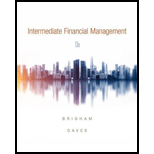
a)
To determine: The definition of interest tax shield and value of tax shield.
a)
Explanation of Solution
The interest tax shield is the amount of cash flow shielded from taxes due to interest tax deductibility. It's the same as
Because MM assume zero growth, the value of the tax shield is T(D). If growth is constant, then the value of the tax shield is
b)
To determine: The definition of adjusted present value (APV) model.
b)
Explanation of Solution
The adjusted present-value model discounts expected free cash flows at rTS's unlevered
c)
To determine: The definition of compressed adjusted present value (CAPV) model.
c)
Explanation of Solution
The condensed modified present-value method discounts expected free cash flows at the unlevered equity cost and also discounted interest tax shields at the unlevered equity cost to determine the value of transactions. It is called the compact APV because there is a discount on the FCF and tax shields at the same price.
d)
To determine: The definition of
d)
Explanation of Solution
This then reduces the FCFEs to hit the price of capital in operations at the leveraged cost of equity. You apply non-operating capital to the value and you get the equity value. You then apply the price of the loan to the value of the transactions. First, the free cash flow for the equity model, or the residual dividend model, measures FCFE, the free cash flow owned by shareholders. FCFE is less interest in cost-free cash flow plus interest tax shield.
Want to see more full solutions like this?
Chapter 17 Solutions
Intermediate Financial Management (MindTap Course List)
- 1. Give one new distribution channels for Virtual Assistance (freelance business) that is not commonly used. - show a chart/diagram to illustrate the flow of the distribution channels. - explain the rationale behind it. (e.g., increased market reach, improved customer experience, cost-efficiency). - connect the given distribution channel to the marketing mix: (How does it align with the overall marketing strategy? Consider product, price, promotion, and place.). - define the target audience: (Age, gender, location, interests, etc.). - lastly, identify potential participants: (Wholesalers, retailers, online platforms, etc.)arrow_forwardAn individual is planning for retirement and aims to withdraw $100,000 at the beginning of each year, starting from the first year of retirement, for an expected retirement period of 20 years. To fund this retirement plan, he intends to make 20 equal annual deposits at the end of each year during his working years. Assume a simple annual interest rate of 20% during his working years and a simple annual interest rate of 5% during retirement. What should his annual deposit amount be to achieve his desired retirement withdrawals? Please write down the steps of your calculation and explain result economic meaning.arrow_forwardAssume an investor buys a share of stock for $18 at t=0 and at the end of the next year (t=1), he buys 12 shares with a unit price of $9 per share. At the end of Year 2 (t=2), the investor sells all shares for $40 per share. At the end of each year in the holding period, the stock paid a $5.00 per share dividend. What is the annual time-weighted rate of return? Please write down the steps of your calculation and explain result economic meaning.arrow_forward
- On how far do you endorse this issue? Analyze the situation critically using official statistics and the literature.arrow_forwardIs globalization a real catalyst for enhancing international business? It is said that relevance of globalization and regionalism in the current situation is dying down. More specifically, concerned has been raised from different walks of life about Nepal’s inability of reaping benefits of joining SAFTA, BIMSTEC and WTO.arrow_forwardIn the derivation of the option pricing formula, we required that a delta-hedged position earn the risk-free rate of return. A different approach to pricing an option is to impose the condition that the actual expected return on the option must equal the equilibrium expected return. Suppose the risk premium on the stock is 0.03, the price of the underlying stock is 111, the call option price is 4.63, and the delta of the call option is 0.4. Determine the risk premium on the option.arrow_forward
- General Financearrow_forwardAssume an investor buys a share of stock for $18 at t = 0 and at the end of the next year (t = 1) , he buys 12 shares with a unit price of $9 per share. At the end of Year 2 (t = 2) , the investor sells all shares for $40 per share. At the end of each year in the holding period, the stock paid a $5.00 per share dividend. What is the annual time-weighted rate of return?arrow_forwardPlease don't use Ai solutionarrow_forward
- A flowchart that depicts the relationships among the input, processing, and output of an AIS is A. a system flowchart. B. a program flowchart. C. an internal control flowchart. D. a document flowchart.arrow_forwardA flowchart that depicts the relationships among the input, processing, and output of an AIS is A. a system flowchart. B. a program flowchart. C. an internal control flowchart. D. a document flowchart.arrow_forwardPlease write proposal which needs On the basis of which you will be writing APR. Write review of at least one article on the study area (Not title) of your interest, which can be finance related study area. Go through the 1. Study area selection (Topic Selection) 2. Review of Literature and development of research of framework 3. Topic Selection 4. Further review of literature and refinement of research fraework 5. Problem definition and research question…arrow_forward
 Intermediate Financial Management (MindTap Course...FinanceISBN:9781337395083Author:Eugene F. Brigham, Phillip R. DavesPublisher:Cengage Learning
Intermediate Financial Management (MindTap Course...FinanceISBN:9781337395083Author:Eugene F. Brigham, Phillip R. DavesPublisher:Cengage Learning
 College Accounting, Chapters 1-27AccountingISBN:9781337794756Author:HEINTZ, James A.Publisher:Cengage Learning,
College Accounting, Chapters 1-27AccountingISBN:9781337794756Author:HEINTZ, James A.Publisher:Cengage Learning, Financial Reporting, Financial Statement Analysis...FinanceISBN:9781285190907Author:James M. Wahlen, Stephen P. Baginski, Mark BradshawPublisher:Cengage LearningPrinciples of Accounting Volume 2AccountingISBN:9781947172609Author:OpenStaxPublisher:OpenStax College
Financial Reporting, Financial Statement Analysis...FinanceISBN:9781285190907Author:James M. Wahlen, Stephen P. Baginski, Mark BradshawPublisher:Cengage LearningPrinciples of Accounting Volume 2AccountingISBN:9781947172609Author:OpenStaxPublisher:OpenStax College





